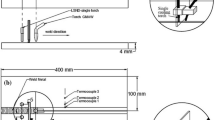Abstract
This study examined the effects of welding residual stress on the compressive behavior and the ultimate strength of the corroded plate. First, welding residual stress was obtained by the thermal elastic-plastic analysis. Then, the change of welding residual stress and the deflection due to the volume loss was investigated by using a newly developed program based on FEM. Finally, the effects of welding residual stress on the compressive behavior and the ultimate strength of the corroded plate were investigated by the elastic-plastic large deformation analysis. As results, the beginning point of the reduction of the initial stiffness with welding residual stress was earlier than that without welding residual stress. Such effect was observed significantly in the case that the volume was lost in the region which has compressive residual stress. Furthermore, the ultimate strength of the corroded plate was reduced by welding residual stress regardless of the plate length, the corroded regions and the reduction of the thickness. The effect of welding residual stress on the ultimate strength became small with the decrease of the thickness.
Similar content being viewed by others
References
Goto, Y. and Kawanishi, N. (2006). “Change of weld residual stresses due to loss of material.”Journal of Structural Engineering, 132(12), pp. 1940–1947.
Japan Road Association (2002).Specifications for highway bridges Part1 Common Part. Maruzen, Tokyo, Japan.
Kim, Y. C., Hirohata, M., Park, D. H., and Asa, Y. (2009). “Treatment of welding imperfection in elastic-plastic large deformation analysis for elucidating compressive behavior of butt-welded plate.”Proc. 5 th International Symposium on Steel Structures, Korean Society of Steel Construction, Korea, pp. 487–494.
Kim, Y. C., Lee, J. Y., Sawada, M., and Inose, K. (2004). “Prediction of welding distortion and residual stress by idealization of welding and its accuracy-In the case of butt welding.”Proc. National Symposium on Welding Mechanics & Design 2004, JWS, Osaka, pp. 391–396 (in Japanese).
Natori, T., Nishikawa, K., Murakoshi, J., and Ohno, T. (2001). “Study on characteristics of corrosion damages in steel bridge members.”Journal of Structural Mechanics and Earthquake Engineering, pp. 299–311 (in Japanese).
Sugiura, K., Tamura, I., Watanabe, E., Itoh, Y., Fujii, K., Nogami, K., and Nagata, K. (2007). “Simplified evaluation of compressive strength of corroded steel plates.”Journal of Structural Engineering, 63A, pp. 43–55 (in Japanese).
Tamagawa, S., Miyoshi, T., and Nara, S. (2008). “Development and application of a finite element analysis based on shell element considering a redistribution of stress caused by corrosion.”Journal of Applied Mechanics, 11, pp. 979–989 (in Japanese).
Author information
Authors and Affiliations
Corresponding author
Rights and permissions
About this article
Cite this article
Tamagawa, S., Kim, YC. Effects of welding residual stress on compressive behavior and ultimate strength of corroded plate. International Journal of Steel Structures 10, 147–155 (2010). https://doi.org/10.1007/BF03215826
Received:
Accepted:
Issue Date:
DOI: https://doi.org/10.1007/BF03215826




